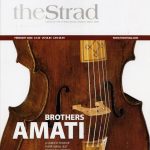The Strad magazine, May 2007 issue: In focus: Augusto Pollastri
Copyright © 2007 Alberto Giordano – The Strad magazine. All rights reserved
A rare cello by Augusto Pollastri
Maker Augusto Pollastri (1877 – 1927) is considered one of the best makers in the Bologna school and an outstanding 20th-century Italian luthier.
History
The son of a miller, Pollastri started working at an early age as an apprentice in the workshop of Raffaele Fiorini (1828 – 98). He opened his own shop around 1897 in a flat in the via Castiglione, Bologna. Pollastri worked in Bologna for his whole life, and was very well known and respected not only in the local area, but also throughout Europe, by musicians such as Pablo Sarasate. In 1927, the year of his death, a violin by Pollastri won a gold medal at the Geneva International Exhibition. In 1906 Pollastri created his own models which, although inspired by his teacher Fiorini, make his instruments easy recognisable. He made 64 instruments, including five cellos.
Construction
Pollastri made his instruments using an external mould, a technique he learnt in the Fiorini workshop. This instrument’s blocks are made of pine and the linings are of willow. Two large wooden pins fix the plates to the rib structure.
Material
The four-piece belly is made from an irregularly grained spruce. The one-piece back and the sides are made from maple cut on the slab, and the head is made from the same wood cut on the quarter.
Archings
Generally quite full and round, these are carved with great care and skill; the front is 28mm high, the back 29 mm high.
Purfling
The black is made of ebony, the white is made of maple, and the thickness is 1.5 mm. The scoop is particularly elegant, and enhances an attractive, round-edged border.
Soundholes
Although inspired by Stradivari, the f-holes reveal Pollastri’s individual personality. The upper holes are barely chamfered, the lower holes are of a slightly oval shape, and the delicate fluting enhances the outline of the wings.
Scroll
The scroll bears the influence of Pollastri’s teacher Fiorini, especially in the elongated button on the profile and in the small-sized eye. It shows Pollastri’s precise and confident execution, and is bold and graceful at the same time. The chamfers are gently rounded, the upper side of the pegbox terminates in a round shape, and the scoop starts flat on the profile and finishes quite deep in the last turn at the eye.
Varnish
This instrument has one of the most beautiful varnishes in 20th-century Italian violin making. Made of oil, it is a deep orange-red colour and is laid over a golden-grey ground. The texture today appears gently crackled and slightly blackened on the top, caused by the colophane powder that was absorbed by the varnish when the instrument was still young.
Label
Although it bears a label dated 1920, the cello was actually made around 1908. It does not yet bear Pollastri’s famous brand drawing of two cockerels, which was only introducted after 1910.
The Strad, may 2007





